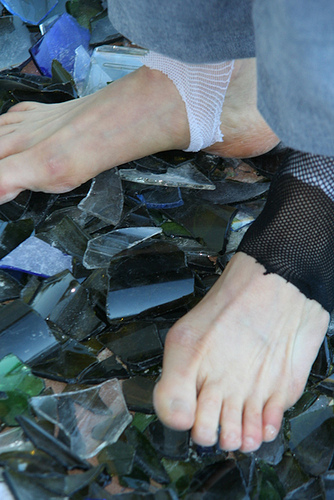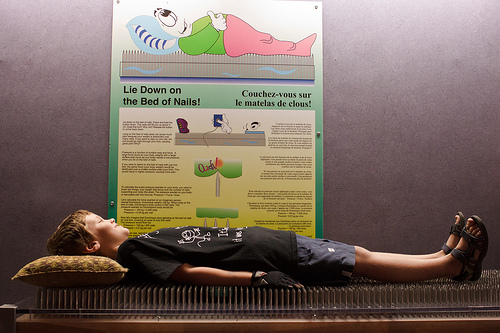Now that the animals are gone from most of the traveling circuses, the majority of the entertainment comes from professional entertainers who demonstrate extraordinary talents. While I don’t recommend running into your backyard and trying to do any of these techniques on your own (most of them are still pretty dangerous), it is interesting to learn just how some of these performances are achieved. If you do think one of these tricks sounds like something you’d like to do, there are plenty of circus and performance schools that will happy to teach you how to safely perfect these skills under the watchful eye of a professional.
Fire Breathing

While fire breathing is something that can be learned relatively easy, it is still a very difficult skill to master and exceptionally dangerous for both the audience members and the performer. When things do go wrong, the mistakes can often be deadly. That’s why most amateur fire breathers start practicing with water long before they ever pick up flammable materials.
The basic concept of fire breathing is simple: spray fuel from your mouth over a hand held flame. The difficulty comes in the perfection of the spraying. If you don’t spray the fuel into a fine enough mist, the fire will fall to the ground and burn. If the spray is too low, it can hit the audience or performer. A high spray can shoot back down and hit the performer. When the wind starts getting in the way, things can become even more complex. Trees, stage implements and audience members can prevent further challenges. Even without the fire hazard, many performers get sick by accidentally ingesting the kerosene before or after their acts.
If you are interested in seeing how good you might be at fire breathing, you can always practice spraying fine mists of water at a 60-80 angle, but if you think you’re getting pretty good, work with a professional before switching to gas. For more info on the act, check out this article.
Image via jeffbalke [Flickr]
Sword Swallowing

If you have a low gag reflex, you’re already halfway on your way to swallowing swords, but there’s a lot more to it than loosening up your throat. Sword swallowing requires the performer to take a straight, hard piece of metal into the curved, soft tissue of the GI tract, all the way into the stomach. While swords used for these performances are not sharp, they are still likely to puncture and scrape the delicate tissue in the GI tract when not swallowed just right. Like fire breathing, this circus act may be a very basic trick, but it can quickly turn deadly when performed incorrectly.
Sword swallowing requires a lot of practice, not only to work through the dangers, but also to train your body to ignore its natural impulses and succumb to involuntary movements ordinarily used while eating. The gag reflex is the first thing you will need to overcome, but as you start swallowing longer objects, you will need to prevent your upper esophageal sphincter from contracting like it does when you eat. Ordinarily, this is a good reflex as it encourages food to enter your stomach faster…when you have a 15 inch sword stuck in your GI tract though, this is not something you want to happen. Depending on how long the sword is, you may even have to train your lower esophageal sphincter not to contract as well, as many swords actually enter the stomach cavity. Keep in mind that you not only have to control all of these inner workings of your body, but you also have to look completely comfortable while doing so.
Like fire breathing, this is something that you should only undertake with the help of a professional trainer at your side. If you do decide to go for it though, you’ll start with short daggers and work your way up. But keep in mind that according to the Sword Swallowers Association, you’re not actually a sword swallower until you can swallow something at least 15 inches. For more information on the risks and challenges of sword swallowing, read this article.
Image via Thairms [Flickr]
Walking On Glass

If you don’t have the dedication to invest years into learning how to breathe fire or swallow swords, glass walking is something you can learn in a surprisingly short amount of time…especially if you cheat. If you just want to psyche out your friends and family, you can always buy sugar glass (the same stuff they use in place of breaking glass for Hollywood movies) and walk along that, but be aware that it can still be kind of sharp sometimes and certain types may leave powdery or syrupy residue that can ruin your trick.
Most sideshow performers do use real glass though and still avoid getting hurt (although many still get minor cuts). The trick is to know how to set up your glass in order to minimize serious risk. Most performers use broken wine bottles because the gentle curves reduce the number of jagged edges. Secondly, the bed of glass is usually pretty thick, which allows the glass more room to shift underfoot and this allows the smallest, most dangerous pieces of glass to fall to the bottom the pile. Once the set up is complete, the glass walkers usually take slow steps that allow the glass to settle before they put full pressure on it. If they do start to step on a sharp point, they reposition their foot to prevent getting injured. For more tips, check out this article.
Image via stevendepolo [Flickr]
Coal Walking

This trick is all about the preparation. The fire must burn way ahead of time so the heat is relatively low by the time the act is ready to go. Ash is then sprinkled on the pit to prevent the walker from stepping directly onto a burning coal. That’s all it takes to prep, then it’s just up to the performer to walk briskly (but never run) across the coals –long enough to build dramatic effect, but fast enough to prevent the heat from the burning center of the coals to transfer into the walker’s skin.
If you ever end up at one of those corporate retreats where they ask you to prove your faith by walking on the coals, now you know how. For more science behind the trick, read this article.
Image via auweia [Flickr]
Bed of Nails

Laying on a bed of nails is like walking on glass or coals, with a little knowledge and the right preparation, just about anyone can do it. Since you Neatoramanauts are pretty smart cookies, I’m sure I don’t need to go into too much detail explaining that when your entire body is spread out on nails that are arranged closely together, the weight is distributed so there is little pressure on any given area.
The most difficult part of this act is actually getting on and off the bed. Never use your hand to steady yourself or you will likely put too much pressure on the area and break the skin. Instead, squat over the edge of the bed of nails and then sit down gently, then slowly turn, lift your legs and lay down flat. Be careful to not press your head down too hard on the nails. Get more tips and details here.
If you’re interested in doing this trick, it is one most people can pick up, so you’ll just need to build your own bed of nails. Instructions can be found here.
Image via dolmansaxlil [Flickr]
So now that you know the means for these tricks, are any of you hoping to run away and join the circus now?
"
No comments:
Post a Comment